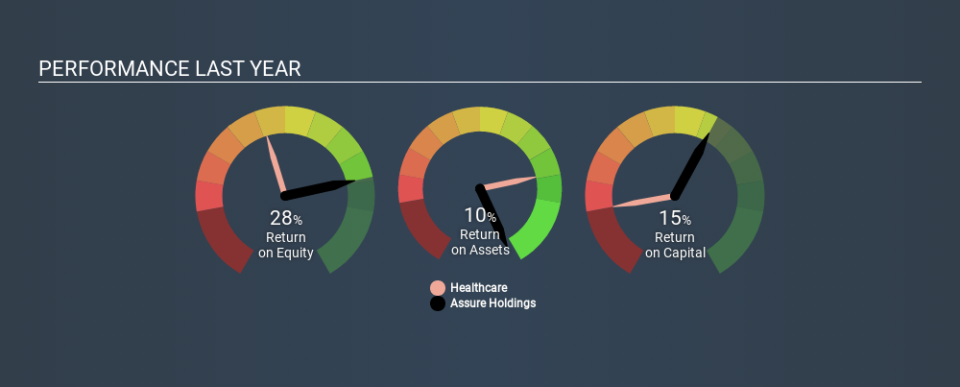A Close Look At Assure Holdings Corp.’s (CVE:IOM) 15% ROCE

Today we are going to look at Assure Holdings Corp. (CVE:IOM) to see whether it might be an attractive investment prospect. To be precise, we'll consider its Return On Capital Employed (ROCE), as that will inform our view of the quality of the business.
First of all, we'll work out how to calculate ROCE. Next, we'll compare it to others in its industry. Finally, we'll look at how its current liabilities affect its ROCE.
Understanding Return On Capital Employed (ROCE)
ROCE is a measure of a company's yearly pre-tax profit (its return), relative to the capital employed in the business. All else being equal, a better business will have a higher ROCE. In brief, it is a useful tool, but it is not without drawbacks. Renowned investment researcher Michael Mauboussin has suggested that a high ROCE can indicate that 'one dollar invested in the company generates value of more than one dollar'.
So, How Do We Calculate ROCE?
Analysts use this formula to calculate return on capital employed:
Return on Capital Employed = Earnings Before Interest and Tax (EBIT) ÷ (Total Assets - Current Liabilities)
Or for Assure Holdings:
0.15 = US$5.8m ÷ (US$44m - US$6.2m) (Based on the trailing twelve months to September 2019.)
Therefore, Assure Holdings has an ROCE of 15%.
View our latest analysis for Assure Holdings
Does Assure Holdings Have A Good ROCE?
When making comparisons between similar businesses, investors may find ROCE useful. Using our data, we find that Assure Holdings's ROCE is meaningfully better than the 9.0% average in the Healthcare industry. We would consider this a positive, as it suggests it is using capital more effectively than other similar companies. Regardless of where Assure Holdings sits next to its industry, its ROCE in absolute terms appears satisfactory, and this company could be worth a closer look.
The image below shows how Assure Holdings's ROCE compares to its industry, and you can click it to see more detail on its past growth.
Remember that this metric is backwards looking - it shows what has happened in the past, and does not accurately predict the future. ROCE can be deceptive for cyclical businesses, as returns can look incredible in boom times, and terribly low in downturns. ROCE is, after all, simply a snap shot of a single year. You can check if Assure Holdings has cyclical profits by looking at this free graph of past earnings, revenue and cash flow.
How Assure Holdings's Current Liabilities Impact Its ROCE
Liabilities, such as supplier bills and bank overdrafts, are referred to as current liabilities if they need to be paid within 12 months. Due to the way ROCE is calculated, a high level of current liabilities makes a company look as though it has less capital employed, and thus can (sometimes unfairly) boost the ROCE. To counter this, investors can check if a company has high current liabilities relative to total assets.
Assure Holdings has total assets of US$44m and current liabilities of US$6.2m. As a result, its current liabilities are equal to approximately 14% of its total assets. Current liabilities are minimal, limiting the impact on ROCE.
What We Can Learn From Assure Holdings's ROCE
This is good to see, and with a sound ROCE, Assure Holdings could be worth a closer look. Assure Holdings shapes up well under this analysis, but it is far from the only business delivering excellent numbers . You might also want to check this free collection of companies delivering excellent earnings growth.
If you are like me, then you will not want to miss this free list of growing companies that insiders are buying.
If you spot an error that warrants correction, please contact the editor at editorial-team@simplywallst.com. This article by Simply Wall St is general in nature. It does not constitute a recommendation to buy or sell any stock, and does not take account of your objectives, or your financial situation. Simply Wall St has no position in the stocks mentioned.
We aim to bring you long-term focused research analysis driven by fundamental data. Note that our analysis may not factor in the latest price-sensitive company announcements or qualitative material. Thank you for reading.

 Yahoo Finance
Yahoo Finance 
